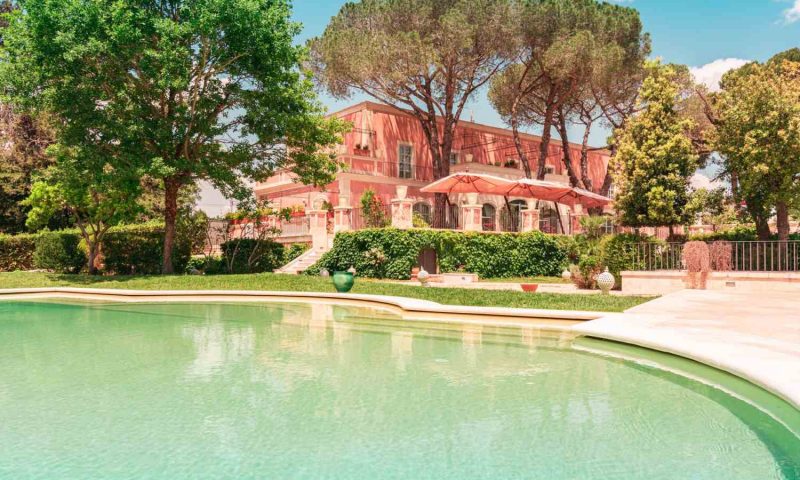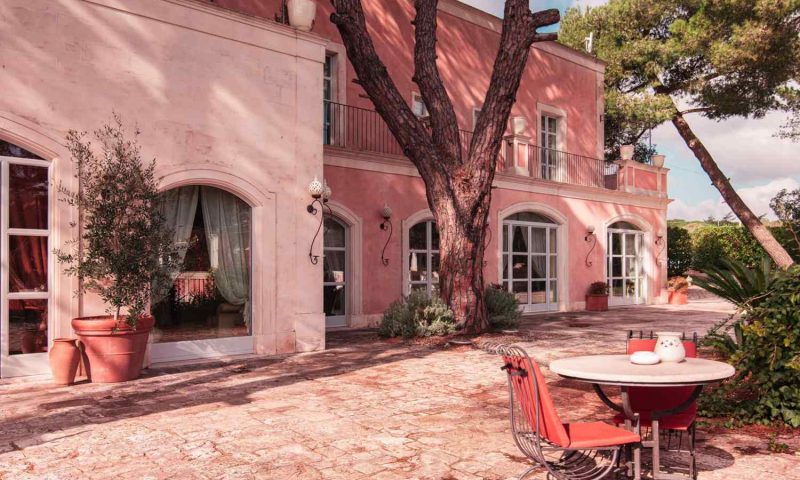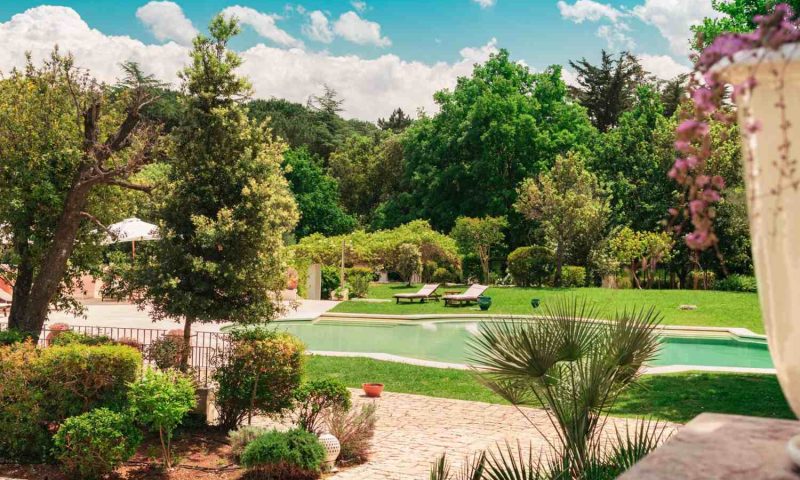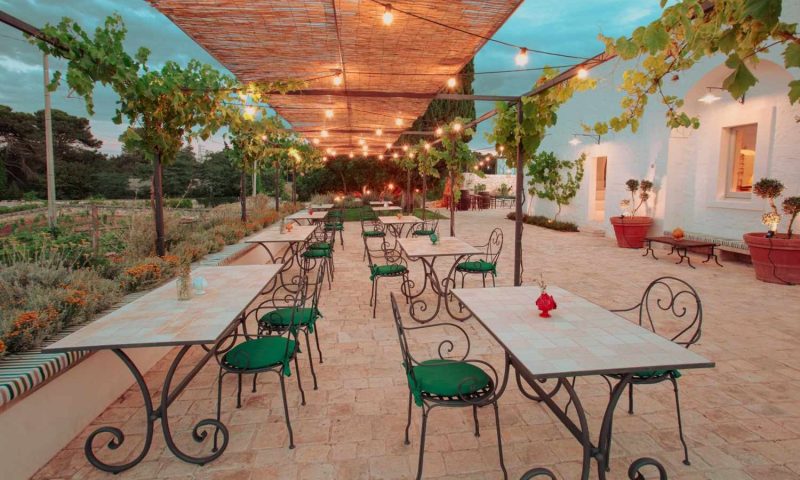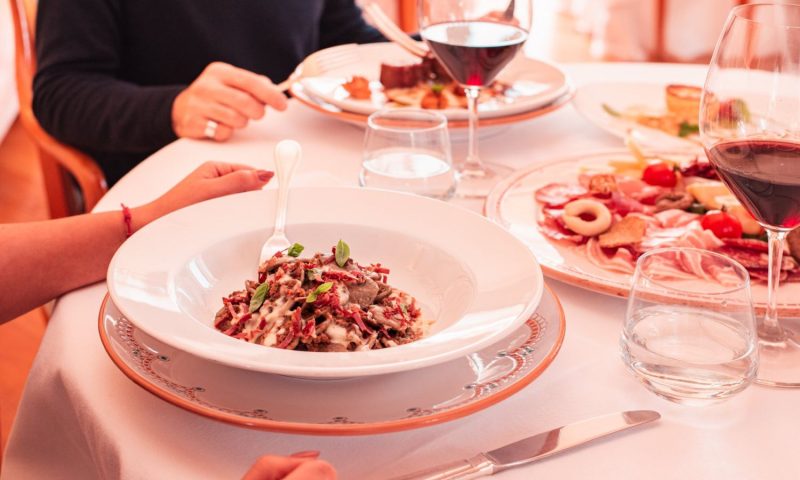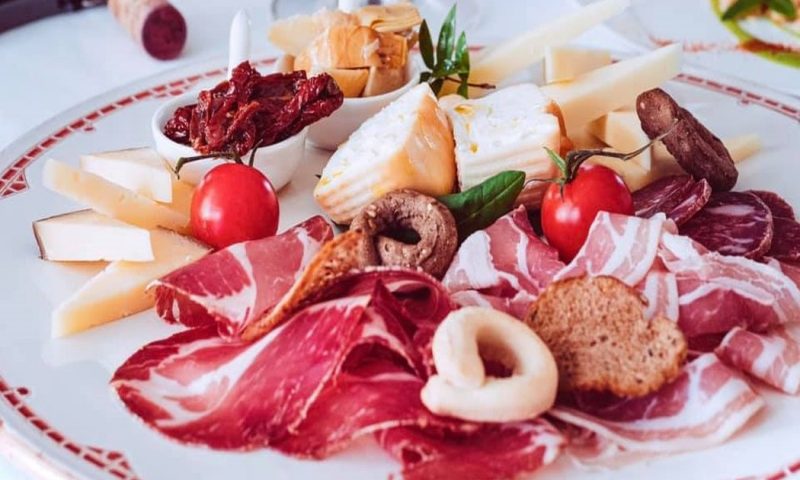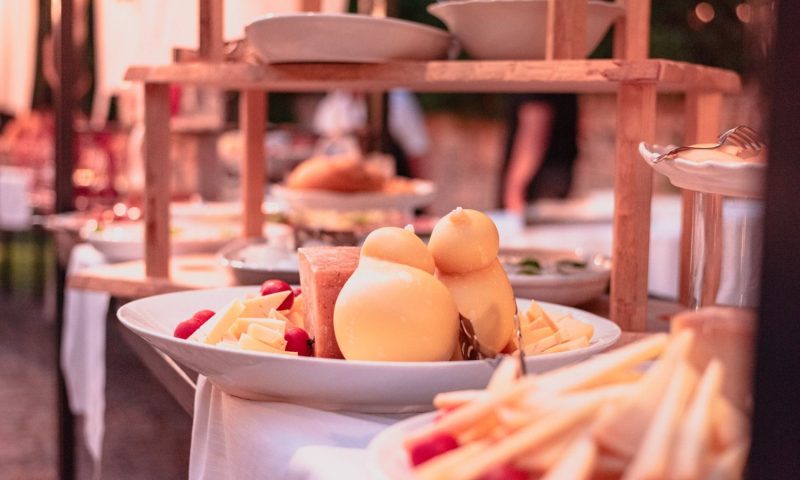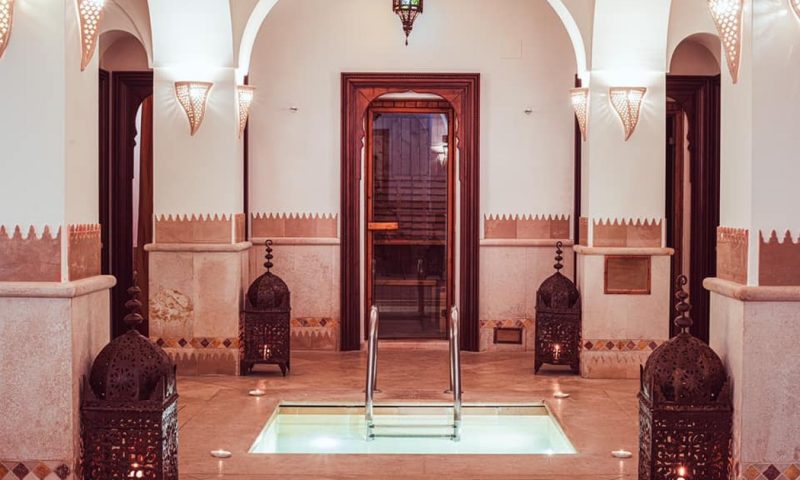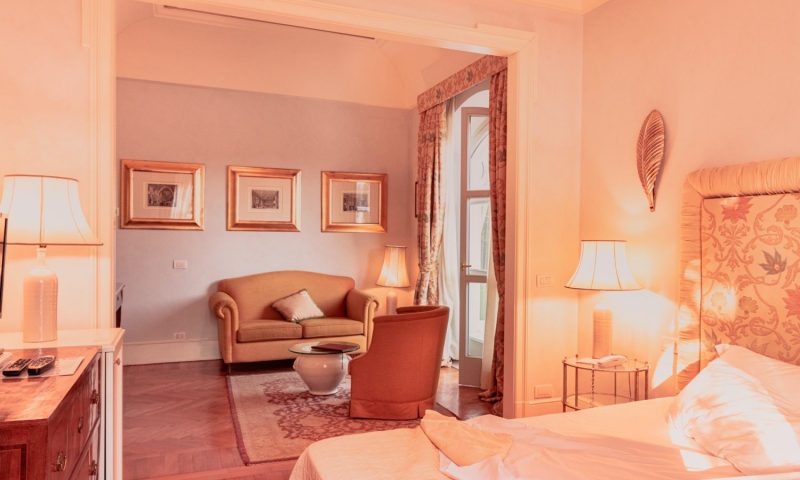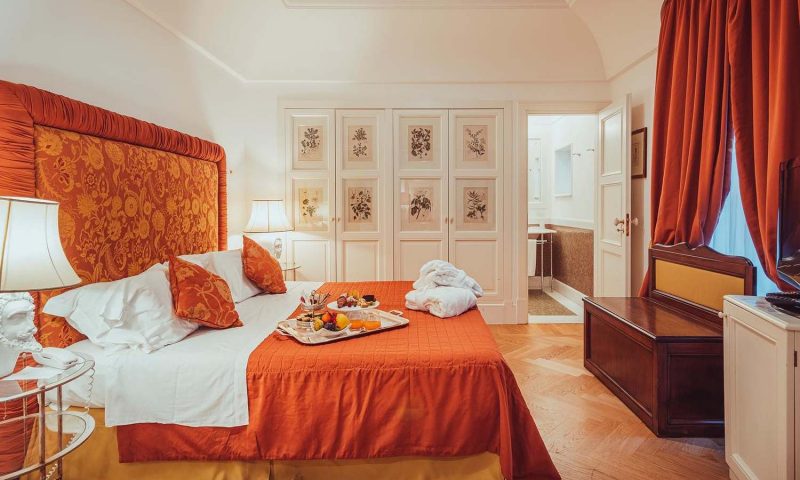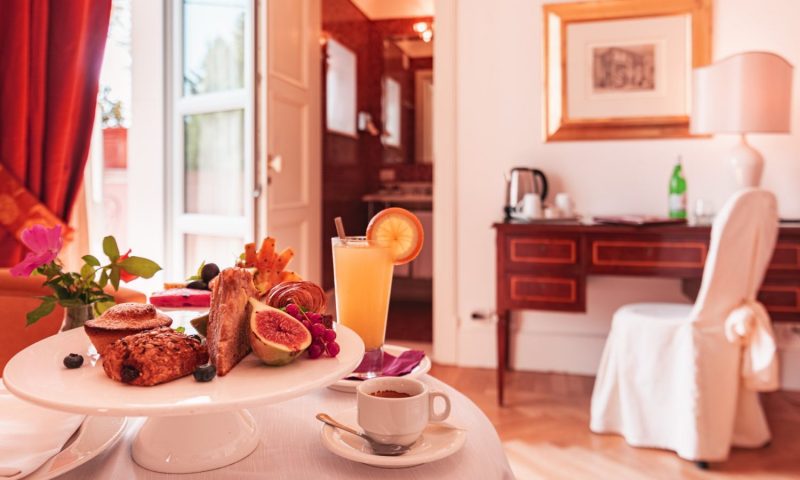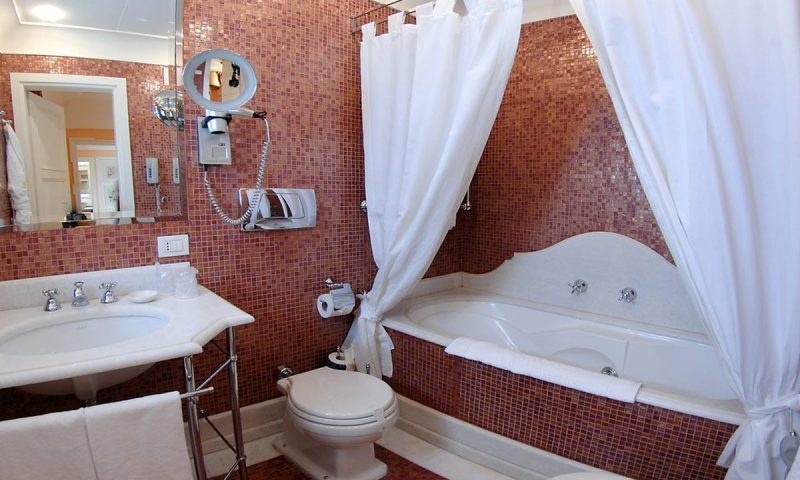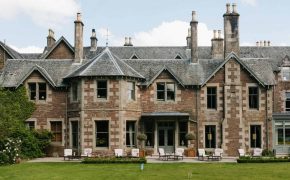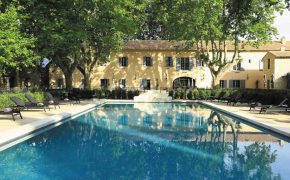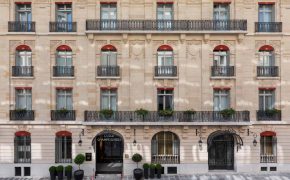At Villa San Martino You can experience a timeless atmosphere. This Masseria from the ‘800, located in the heart of the Itria Valley, is characterized by the unique traits of the panorama of Murgia mixed together with elegance.
An accurate care for the details is evident in every spot of the Resort, where comfort and a keen sense of aesthetic blend together in order to gift our Guests with a vacation characterized by beauty, wellness, culture and by the wide variety of quality food and wine from Apulia.
Being inside a completely natural frame, in this location style and refinement predominate. The charm of tradition and the modernity of our services donate a high-class hospitality to anyone who decides to live moments of well-being, unforgettable receptions, meeting and events of different kind, according to each individual exigence.
Villa San Martino is the essence of luxury, a charming dwelling, which is only a few kilometers far from Martina Franca, a renowned baroque town, where it is possible to admire the magical historical center and to be surprised by its exquisite traditional food and wine.
Fine and clean air enshroud the Villa and give a sense of stillness. Villa San Martino is a charming, recently-renovated location, which arose out of the historical stones of a Masseria from the ‘800 and is now recognized as one of the most beautiful among the hotel facilities of the Itria Valley.
Walking along its enchanting walls, it is possible to notice a refined and exclusive location, in which the charm of the past is in direct contact with the comfort of modernity. Surrounded by the florid and quite Apulian countryside, rich of secular trees and heady scents, Villa San Martino welcomes its Guests by awakening Their senses.
The hotel’s decor and the precious textiles will rouse the enthusiasm of touch; the perfumes and sounds of nature will stimulate olfaction and hearing; furthermore, the colors of the landscape and the flavors of our cuisine will strengthen sight and taste.
ROOMS & SUITES
This mixture of past and present, old and new, has always had a strong appeal, to the point that an ancient nineteenth-century Masseria has been transformed into a romantic contemporary residence. The peculiar style of Villa San Martino is the result of an accurate choice of colors and natural materials of the proper Apulian tradition.
An old-fashioned Villa redefined for the modern age, a place where immense outdoors have been set up with a gazebo and curtains and where the beauty of the location is in harmony with the surrounding landscape.
To spend the night at Villa San Martino means to enjoy the greatest privacy and comfort desirable in luxury rooms and suites. The 21 rooms provided by Villa San Martino are a continuous mixture of antique and modern, perfectly blended together.
Rooms are divided into: 11 Double Deluxe Rooms, 2 Triple Deluxe Rooms, 8 Junior Suites, all set up exclusively with high-quality materials. Two of our rooms are thought to meet the exigencies of people with disabilities.
Inside the rooms everything was studied and designed aiming at raising the pleasure of Your stay. In each room, alongside the vintage decor, the damask curtains from the best silk factories of Caserta, and marbled bathrooms, You can find design furniture, comfort and a Jacuzzi bathtub.
The flagship of the Villa is the swimming pool and its surrounding area, ideal for sunbathing and to donate moments of wellness for both body and mind.
SUITE
This exclusive suite is the largest and most comfortable room in the Villa with its 28 square meters in size and a wonderful furnished terrace with a central view of the entire park with swimming pool.
Refined taste and classy furnishings among decorated ceramics, antique furniture and fine textiles characterized the San Martino suite. Located in the central Maison on the second floor with elevator, it has a sitting area and double bathroom with jacuzzi tub and with shower
EXECUTIVE SUITE
Executive Suites are designed to meet the need for larger spaces by having two bathrooms and a living area with sofa. Ideal for families, these refined rooms can become quadruple. They are then equipped with handicap accessibility. The large furnished terrace they benefit from is an opportunity for relaxation and privacy surrounded by nature.
JUNIOR SUITE
Junior Suites represent a break from the frenetic and noisy everyday life, offering a breathtaking view that anticipates the local sights. Fine taste, prestigious furniture with decored ceramics and precious textiles.
With their 24 sqm, these rooms are completed by a living area and an intimate private terrace overlooking the garden. They are located on the first floor with elevator.
DELUXE
Deluxe Rooms offer our Guests the pleasure of enjoying sophisticated and overly-refined settings. Provided with every comfort and with hydro massage tub, these rooms extend over a surface of 18 sqm, and are located on the first floor with elevator. Cozy rooms are designed to let our Guests enjoy the tranquility of a relaxing context.
DINING
The park, the stars, our culinary high-class proposals all together make Villa San Martino’s dining services a reason of pride for both the Italian and the foreign Guests we host.
The cuisine offered by the restaurant of Villa San Martino is typical of our tradition but marked by the fine and personal intervention of the Chef, made possible every day thanks to the use of fresh and genuine ingredients.
THE DUCA DI MARTINA RESTAURANT
The “Duca Di Martina” is considered among the best typical Apulian restaurants. A large room constitutes the Restaurant, decorated with an elegant and classical style, which is in harmony with the surrounding spaces. It provides a capacity of maximum 100 covers.
The intimate room provided by the restaurant is instead ideal for a romantic stay, as the suffuse lighting will generate a romantic and warm atmosphere, where You will enjoy several Apulian delicacies.
The “Duca Di Martina” presents itself as a gourmet restaurant, the right place to experience the great variety of Apulian Cuisine. Exquisite specialties, appetizing tasters, great wine and seasonal produces are served with passion to please even the most exigent palates.
BAR
Villa San Martino’s Lounge Bar, with its exclusive atmosphere, is located in proximity to the open-air lobby. A meeting point, a place to take a break during the day, chatting friendly and sharing memories.
Hospitality in the charming ambience of the Itria Valley will be guaranteed, thanks to a service, which is always attentive and caring. During summer Villa San Martino enriches its services with the Kiosk by the swimming pool: here our guests may taste refreshing cocktails, thus enjoying a totally relaxing atmosphere.
BREAKFAST
At breakfast, the “Duca Di Martina” loves to take care of its Guests with genuine ingredients that will awake the five senses and will create the right alchemy to welcome a day reserved to harmony and wellness.
The typical breakfast served at Villa San Martino is rich of perfumes and colors recognizable on our buffet of “Buon Risveglio” (the “Good wake up” buffet). Delicacies prepared by the pastry Chef are part of the breakfast ritual: homemade brioches, cakes, tartes, muffins, biscuits and other small culinary delights.
The “cafeteria” proposes a prime quality selection, able to meet any kind of exigence: from the Italian Espresso made with grains of various provenances to the America coffee, high-quality milk, soy milk and a rich assortment of tea and precious infusions.
Anyone desiring to have a Healthy breakfast, can taste fresh seasonal fruit and fruit compotes, extracts, cereals of any kind and a wide variety of jams and yoghurts. For those who love English Breakfast, we provide a selection of savory foods, vegetables, cheese, cold cuts, together with a menu with egg-based receipts, prepared according to the English tradition.
DINNER
Villa San Martino hosts the “Duca Di Martina” restaurant, where You can taste the typical Apulian Cuisine, with revisited flavors. The Chef carefully selects seasonal produces, with a strong commitment to meeting the exigencies of our Guests, who can benefit from various proposals of typical dishes, that cover a wide selection of the rich culinary Apulian heritage.
Every receipt is elaborated with local high-quality produces. The aim is to engage our Guests and to surprise them with the typical flavors of the Apulian Cuisine, offering an opportunity to enrich Their experience with a Culture of Food and Wine, which has many stories to tell.
A menu of both tradition and novelty, that keeps a strong relation with the local territory with a bit of innovation, to create unique and original meals.
NINÒ – IL TRULLO DI SAN MARTINO
The deepest roots of Puglia told through the rural and homely dimension of Ninò, the trullo of Villa San Martino. The Apulian trulli are the backdrop for a research into the excellent raw materials of the area, in a sensory journey where the colours of the Mediterranean converge with the strong flavours of the local cuisine.
From highly selected cold cuts and cheeses to locally bred meats, legumes and vegetables from our garden. The ancient recipes of the peasant cuisine – both heritage and tradition – are revived and enhanced by an exclusively Apulian wine list.
WEDDINGS IN APULIA
Welcome at Villa San Martino, in Apulia, in the heart of the Itria Valley, not far from the seaside and immersed in a green, typically Mediterranean landscape. Surrounded by a 10.000 square meters park, the Villa embraces luxuriant gardens, a swimming pool, six different locations and an organization of the highest level.
In every season, both in the wintertime and in the summertime, the interiors and outdoors of Villa San Martino lend themselves well to planning daytime or evening weddings, or weddings in the magical Christmas time, to make your best dreams come true.
The Villa offers the possibility to host not only wedding receptions, but also the characteristic civil ceremony and the stay of the wedding’s guests. Expert wedding assistants are available to guide the bride and groom in the choice and care of every detail.
Classic, fun or elegant? At Villa San Martino every event is unique. Our spaces are shaped according to your desires. This is the best way to leave an unforgettable memory in your guests’ hearts.
CONFERENCES & MEETINGS
The capacity of our locations allows Villa San Martino to offer the possibility of planning meetings and professional events of any kind. The two Conference Halls can receive a vast public: they are respectively provided with 160 sittings in the main Hall and other 130 sittings in the second one.
Furthermore, we can provide You with the needed audio-visual equipment, a paper-board and a screen; for any further necessity in terms of equipment and technical assistance feel free to ask.
To make any event special and detail-cared, Villa San Martino disposes of catering services, such as coffee break, light lunch, welcoming appetizer, “business breakfast”, social dinner, gala dinner, typical dinner or theme dinner.
EXPERIENCE PUGLIA
Each tour includes food tastings directly from the producers, relaxing walks around the most popular cities of Puglia and “off-the-beaten-path” itineraries to visit hidden historical treasures, beautiful piazzas and awe-inspiring landscapes that you otherwise would miss.
Apulia is famous for its pristine nature, rich of olive trees, coasts and dry-stone walls. Choose to discover it riding your bike, exploring the Trulli of the Itria Valley and stopping in a Masseria to taste zero-mile products, such as Capocollo of Martina Franca and Caciocavallo cheese.
During the summer, let the sea breeze of the Adriatic coast caress you, cities like Polignano a Mare, Torre Canne and Savelletri, or choose to have a cruise to relax and discrover the two seas of Taranto.
COOKING CLASS
Explore the typical Apulian cuisine with our Chef! Our Chef will teach you how to prepare the real Apulian orecchiette pasta and focaccia. At the end you will be taste what you will realize; during lunch there will be the Buvette of drinks (water, wine and juices).
All participants will be provided with kitchen utensils (rolling pin, pastry board, bowl etc) and at the end of the course the Certificate of participation will be issued. Classes will have at least 2 participants up to a maximum of 8.
CHEESE MAKING CLASS
The guest will discover all the secrets of dairy products, visiting the cheese factory, the farm, the maturing cells and the Family Chapel. After the “Mozzarella Show” during which the dairyman will show the production processes, the guests will take part into the production process, too. Lunch, tasting traditional food of Puglia.
UNESCO TOUR
Visit a cave-house entirely and typically furnished to understand the customs and traditions of the inhabitants of the ancient Sassi districts, before their abandonment. Also, visit to a Cave Church, dating back to the 8th Century, the most important in the history of Matera.
At the end of the walk, visit to a bakery and tasting of Matera bread, which has become an IGP product thanks to its historical and organoleptic qualities. Alberobello: Visit to the amazing Church of Sant’Antonio, the only trullo-shaped church in the world.
*The experience ends with the tasting of unique and unequivocal products of Puglia, surrounded by an incredible scenery that only a sea view location can offer. The appetizer consists of crunchy taralli and slices of bread seasoned with tomato and olive oil, appetizing local olives, crudités and salty croissants stuffed with local salami along with an indispensable glass of local wine.
MARTINA FRANCA
Martina Franca rises up on the east low hills of the Murgia, at equal from both the Adriatic and the Ionic seas; indeed, it benefits from a privileged position, as it is central to the most important cultural sites and landscapes of Apulia. Martina Franca is a melting pot of history and art. For more than 40 years it has been hosting the Festival of the Itria Valley, among the most important opera festivals in Italy.
Its historical center with dominant white tones is made precious by the magnificent portals and balconies of the old elegant mansions in Rococo style, among which it’s worth mentioning the sumptuous Palazzo Ducale, but also Palazzo Martucci, Palazzo dell’Università, Palazzo Motolese, Palazzo Maggi, Palazzo Ancona and, still within the medieval city walls, the imposing Basilica of San Martino, which preserves sculptures by Stefano da Putignano and by Giuseppe Sammartino.
If you wish to discover the rural soul of this territory, you should explore the countryside, where characteristic Trulli, beautiful masserie and plantations framed by dry stone walls and by wild scents stand out.
Various products from the agri-food and wine industry are noteworthy: among them the Capocollo of Martina Franca (Slow Food product), the podolic caciocavallo cheese, and wines of two local varieties, Verdeca and Bianca d’Alessano.
On the 11th of November the inhabitants of Martina Franca celebrate their patron saint, San Martino, to whom the city partly owes its name, as he saved Martina’s residents from the Saracen invasions.
ALBEROBELLO
City if the Itria Valley and of the Murgia area of the Trulli. This city is renowned for its characteristic dwellings called “Trulli”, that from the 5th of December 1996 are part of the UNESCO Heritage and within the World Heritage List, with the following reasons: “exceptional typology, continuity of housing, survival of a prehistoric building culture…”
In particular, the Rione Monti and the Aia Piccola represent the most suggestive and ancient districts of the town. Today the area of Rione Monti is dedicated to business activities, whereas the Rione Aia Piccola has preserved its traditional residences: here it is possible to completely immerse oneself in the history and ancient traditions of this town.
Do not miss the “Trulli Siamesi” and the “Trullo Sovrano”, the last one representing the greatest design capacity reached in a Trullo and, at the same time, it introduces a new a new building phase that includes the use of mortar.
OSTUNI
The urbanistic identity of Ostuni lies in its old village, named by its inhabitants “La Terra”. A unique built-up area stands out on the highest hill of the urban area: all painted in white and characterized by a multiplicity of levels, alleys and stairs made of stone, little streets that intersect arches and squares, cubicle houses, often dug into the rock.
The houses coated with lime and the peculiar topography gifted the city with fairy-tale epithets, such as “Città Bianca” (‘The White city’), “Regina degli Ulivi” (‘Queen of the olive trees’) and “Città Presepe” (‘Nativity scene city’). Once reached the highest point of the city, it is possible to admire the beauties of the Cathedral and of Palazzo Vescovile (the Bishop’s Palace).
CISTERNINO
Cisternino is adorned with the Orange Flag, brand of high quality tourism and environment, conferred by Touring Club Italiano and dedicated to the small towns of the hinterland that stand out for their excellent offer and for their quality hospitality.
Cisternino is characterized by good accessibility and by an efficient management of the local mobility. The most important entrance to the heart of the old city is Porta Grande.
The urban fabric with its medieval imprint remained almost intact and it is possible to lose oneself in the authentic atmospheres of the four districts “Bère Vécchie”, “Scheledd”, “U Pantène”, “L’ìsule”, that together with the outermost one, named “u Bùrie”, compose a small maze of alleys and widenings, where white houses, streets adorned with geraniums, stairs, lodges and arches alternate.
LOCOROTONDO
Its name already indicates the characteristic circular shape of the historical center of this town, risen around the year thousand and constituted by a series of huts that the local agricultures build on the top of the hill, among which we mention the typical “cummerse”, little houses with pitched roof.
Among the dwellings of the historical center stand out the steeples of the many churches of the town, such as Chiesa dell’Addolorata, Chiesa dello Spirito Santo, the San Nicola Church, the San Rocco Church and the Church dedicated to Madonna della Catena.
Inside the Church of Santa Maria della Greca, a Renaissance polyptych dedicated to the Madonna delle Rose and the sculpture group of St. George on horse are preserved.
From Piazza Vittorio Emanuele, where two imposing pillars identify Porta Napoli, a path stretches from the little municipal palace, today municipal library (end of the ‘700), through the baroque Palazzo Morelli, with its splendid gate and the balconies with railings in a particular wrought iron (named “goose breast”), to the Chiesa Madre.
Locorotondo is awarded with the Orange Flag, brand of high quality tourism and environment, conferred by Touring Club Italiano and dedicated to the small towns of the hinterland that stand out for their excellent offer and for their quality hospitality.
TARANTO
Taranto, named “the city of the two seas”, overlooks Mar Grande and Mar Piccolo, benefiting from a strategic position, which made it protagonist of well-known historical events.
Precious ancient evidences are preserved at Marta, the national archeological museum, where it is possible to admire the famous “Ori di Taranto” (Taranto’s Golden Treasure), refined productions of local goldsmith’s art between the IV and the II century BC, together with the immense collection of archeological findings from all over the Ionic province.
The history of Taranto is outlined by the two bridges that connect the old city with the new one. Alongside the stone bridge build after the flood of the year 1883, a swing bridge was introduced in 1887, manifesting the charm that the great mechanic engineering works have, and it leads to the maze of the alleys in proximity to the central Via Cava, where it is possible to find various artisan shops.
In this isthmus of land stand out noble architectures and churches of different times and styles, like the Cathedral dedicated to St. Catald, a mixture of Romanic and Baroque style, or the Church of St. Domenico, with gothic elements.
FASANO
The historical center is characterized by alleys, white walls, arches and small squares. The ancient walls still preserve the Torrione delle Fogge, once one of the entrances to the city.
In the neighboring areas you will not want to miss the archeological excavations of Egnazia and the Zoosafari, the biggest faunistic park of Italy. Also, don’t miss the dolmen of Montalbano, which dates back to the Bronze Age, around the 2000-1500 BC, and which is still intact.
Along the highway 16, close to a “lama” (a groove which is typical of the karstic territory) and nearby a masseria, rises Tempietto di Seppanibbale, dating back IX century and realized with big blocks of local stone. In the inside it preserves a notable series of frescoes of Langobard age.
MATERA
Matera is the city of Sassi (ancient habitations) and from 1993 it is part of the UNESCO Heritage. It is one of the oldest cities of the world, and its territory preserves evidences of human settlements from the Paleolithic.
The original urban nucleus developed out of the natural caves dug into the rock and afterwards shaped into more and more complex structures, placed inside two large natural amphitheaters, known as the Sasso Caveoso and Sasso Barisano.
The unique architecture of the Sassi evokes the human capability to perfectly adapt to its natural environment and context, making masterful use of simple elements, such as the constant temperature of the excavated spaces, the calcarenite of the rock itself for the construction of “out of ground” housings, and the use of slopes to control the waters and the meteoric phenomena.
The architectonical structure is constituted by two systems: the former being immediately visible, and realized through the stratification of housings, courtyards, balconies, palaces, churches, streets, gardens; the latter less visible at first sight, and constituted by tanks, icehouses, caves, tunnels and water monitoring systems, essentials for the wellbeing of the community.
The landscape of the Sassi extends through the ravines typical of the near Gravina di Puglia, with a landscape that is in continuity with Matera and its characteristics.
VISIT LECCE
Italian city of art, Lecce is also known as “the Baroque Woman”: the ancient Messapian origins and the archeological findings of Roman origin blend together with the richness and extravagance of the Baroque from the XVII century of the churches and the palaces of the city center, made of local stone, a particularly malleable limestone that lends itself well to working with the scalpel.
Richly decorated buildings, elegant streets and surprising squares characterize the city. Charming square of the historical center is the splendid Piazza Sant’Oronzo, with its Roman amphitheater, the colonnade of the Saint and the Sedile palace, today tourism information point. Not far away are the Teatini Convent and the Sant’Irene Church, a Baroque masterpiece.
POLIGNANO
Polignano a Mare, known as the “Adriatic Pearl” is only 33km far from the city of Bari. The oldest nucleus of the city rises on a rocky spur overlooking the Adriatic Sea. Native city of the singer Domenico Modugno, who became famous thanks to his “Nel blu dipinto di blu”, Polignano fascinates with its historical center, rich of traces of different origins (Arabian, Byzantine, Spanish, Norman), like the remains of the four imposing defense towers that used to enclose the old village.
Worth mentioning is the bridge of the Via Traiana, still accessible today, which crosses Lama Monachile. From “Arco della Porta”, once the only entrance to the city, it is possible to walk through this magical hamlet, which is enriched by the the XIII century Chiesa Matrice dedicated to the Assumption.
Don’t miss to visit the Museum “Pino Pascali” Foundation, set up in the former municipal slaughterhouse and dedicated to the work of the great Apulian sculptor and artist. The Polignano coast, which stretches from Grotta Palazzese to Lama Monachile, is one of the most beautiful in Apulia, thanks to its hidden coves and to the lovely sandy inlets.
TORRE CANNE
Immersed in the “Parco naturale Dune Costiere” (the coastal dunes natural park), from Torre Canne to Torre San Leonardo, this city overlooks the Adriatic Sea and is 8 km far from Fasano. Symbol of this thermal locality is the lighthouse, which lights up the coast, the sea and the long cliffs.
From the ‘80s, it started to grow, becoming a lively seaside area that benefits from crystal sea waters and fine white sand beaches. Torre Canne is renowned for its thermal center, a place to benefit from the therapeutic virtues of the spring waters.
In the adjacent areas you can visit fortified masserias immersed in olive tree fields or the faunistic site of the Zoosafari in Fasano. Torre Canne is also the homeland of the Slow Food “Regina” Tomato, arranged in vermillion “ramasole” that embellish the local dwellings.
SAVELLETRI
The fascinating Savvelletri is a suggestive Adriatic spot surrounded by cliffs, about 5 km far from Fasano. Mostly known for its sea and for its amazing equipped beaches, Savelletri is a popular tourist destination.
The beaches in sand and cliffs are not excessively crowded and offer either free access or private areas, that offer their best during good weather. Savvelletri is ideal for a vacation of exclusive relax.
The Archeological Park of Egnazia is a real treasure of findings, whereas the near golf field is one of the best in Apulia, counting 18 holes. The right occasion to taste some quality swordfish is the Patron Saint’s celebration (in august) dedicated to San Francesco da Paola and celebrated with a charming procession by the sea and a traditional festival.
MONOPOLI
The beautiful Monopoli overlooks the Adriatic Sea and is introduced by the castle and its ancient walls. The city is known for its 99 districts, called “contrada”, which extend on a flat area, embraced by the splendid Loggia del Pilato’s “belvedere”, a natural terrace to admire an authentic landscape made of fortified masserie, churches, rocky settlements and villas.
Symbol of the city is the monumental Castel dedicated to Carlo V, which hosts expositions, conferences and today is site of the municipal Archeological Museum. The fortified masserie are well preserved or they were restored with care; they are located in the heart of the marine landscape, in the area of the low hills and in the flat hinterland.
Monopoli is also a hamlet for fishermen; it was founded on the seaside and presents a 15km coastline which is low and indented, characterize by numerous coves and long sandy beaches. Special celebrations for the city are dedicated to St. Cosma and Damiano, and to the memory of the landing of the raft with the icon of Madonna della Madia.
GROTTAGLIE
Grottaglie finds its origins in the surrounding spectacular green canyons, a territory marked by the presence of ravines, where many caves were excavated.
The city of Grottaglie was made famous worldwide by the art of working ceramics: around its historical center, characterized by winding streets and by low-vault houses, extends the “ceramics district”: here the creativity of the artisans gives birth to refined terracotta works.
In more than 50 workshops artisans still use the traditional lathes to create plates, vases, holy water fonts, ladies and knights and the famous “pomo” in enamelled ceramic, symbol or the ceramicist art of Grottaglie, an art that has been handed down from father to son.
In the moat of a castle of the 1400 for centuries artisans have been shaping and decorating clay: a scenery that is unique in the world. Artisan works also celebrate the patron St. Cyrus and the occasion of the lighting of the pyre on the 31st of august, a bonfire that burns in memory of the martyrdom of Grottaglie’s patron saint.
